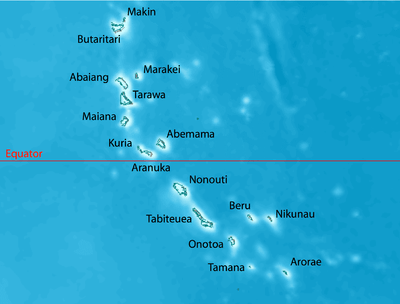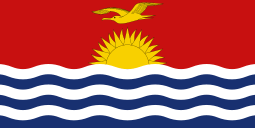Tabiteuea
Tabiteuea, formerly Drummond's Island, is an atoll in the Gilbert Islands, Kiribati, farther south of the Tarawa Atoll. The atoll consists of two main islands: Eanikai in the north, Nuguti in the south, and several smaller islets in between along the eastern rim of the atoll. The atoll has a total land area of 38 km2 (15 sq mi), while the lagoon measures 365 km2 (141 sq mi). The population numbered 4,899 in 2005, The islanders have customary fishing practices related to the lagoon and the open ocean.[1]
 Satellite photograph of Tabiteuea (NE top) | |
 | |
| Geography | |
|---|---|
| Location | Pacific Ocean |
| Coordinates | |
| Archipelago | Gilbert Islands |
| Area | 40.33 km2 (15.57 sq mi) |
| Highest elevation | 3 m (10 ft) |
| Administration | |
| Capital | Utiroa |
| Former capital | Buariki |
| Demographics | |
| Population | 5,261 (2015 Census) |
| Pop. density | 123.8/km2 (320.6/sq mi) |
| Ethnic groups | I-Kiribati 99.7% |

While most atolls of the Gilbert Islands correspond to local government areas governed by island councils, Tabiteuea, like the main atoll Tarawa, is divided into two:
History
"Tabiteuea" is Gilbertese for "no chief allowed"; the island is traditionally egalitarian. In the late 1800s, the two islands were the site of a religious war when the populace of Tabiteuea North converted to Christianity and, led by a Hawaiian pastor called Kapu who had assembled a "hymn-singing army on a crusade", invaded and conquered Tabiteuea South, which had maintained traditional religious practice.[4]
The Battle of Drummond's Island occurred during the United States Exploring Expedition in April 1841 at Tabiteuea, then known as Drummond's Island. After one sailor from sloop USS Peacock, was captured by the islanders, the US party decided on exacting redress for the incident. Twelve islanders were killed in the fighting and others were wounded.[5]
During the US Civil War, the Confederate States Navy steamer CSS Shenandoah visited the island on March 23, 1865 in search of United States whalers, but the whalers had fled the area. Captain James Waddell described the islanders as "of copper colour, short of statue, athletic in form, intelligent and docile" and were "without a stitch of clothing".[6]
Tabiteuea Post Office opened around 1911 and was renamed Tabiteuea North around 1972. Tabiteuea South Post Office opened on 13 September 1965.[7]
Education
There is a government high school, Tabiteuea North Senior Secondary School,[8] also known as Teabike College.[9] Located in Eita, it serves the entire island.[10]
There is also a government junior high school, Takoronga School in Terikiai, serving all of Tab North.
The elementary schools on Tab North are all government schools. They include:[10]
- Aiwa: Nukantewaa School, which also serves Bangai
- Buota: Taunibong School, which also serves Tanaeang
- Eita: Temwamwang School, which serves a portion of Eita as well as Utiroa; the school does not serve all of Eita, as Eita and Utiroa are both the settlements with the most people in Tabiteuea North.
- Kabuna: Kabuna School
- Tekaman: Burannikoraoi School, which also serves Tekabwibwi
- Terikiai: Takoronga School, which also serves a section of Eita; Kiribati authorities included a section of Eita in its attendance zone to relieve Temwamwang School
- Tanaatoorua: Ueen Maungan te Raoi School, which also serves Bangai
- Taumwa: Auriaria School
Students from Bangai may attend either Nukantewaa School or Ueen Maungan te Raoi School; Bangai does not have enough residents, so the Kiribati authorities do not operate a school there.[10]
Transport
There are two domestic airports:
- Tabiteuea North Airport that is the main hub deserving the southern Gilbert Islands;
- Tabiteuea South Airport, only deserving Tabiteuea South.
Gallery
 A drawing by Alfred Thomas Agate featuring a warrior of Drummond Island in 1841
A drawing by Alfred Thomas Agate featuring a warrior of Drummond Island in 1841 Drawing of a native of the island, showing his distinctive conical headdress; drawn by Alfred Thomas Agate
Drawing of a native of the island, showing his distinctive conical headdress; drawn by Alfred Thomas Agate
References
- Luomala, Katharine (1980). "Some fishing customs and beliefs in Tabiteuea (Gilbert Islands, Micronesia)". Anthropos. 75:3/4: 523–558.
- "12. Tabiteuea North" (PDF). Office of Te Beretitent - Republic of Kiribati Island Report Series. 2012. Retrieved 28 April 2015.
- "13. Tabiteuea South" (PDF). Office of Te Beretitent - Republic of Kiribati Island Report Series. 2012. Retrieved 28 April 2015.
- MACDONALD, Barrie, Cinderellas of the Empire: Towards a history of Kiribati and Tuvalu, 2001, ISBN 982-02-0335-X, p.38
- Ellsworth, Harry A. (1974). One Hundred Eighty Landings of United States Marines 1800 to 1934. Washington D.C.: US Marines History and Museums Division. pp. 72–74.
- WADDELL, James C.S.S. Shenandoah: The Memoirs of Lieutenant Commanding James I. Waddell, 1996, ISBN 1-55750-368-0, p.143
- Premier Postal History. "Post Office List". Premier Postal Auctions. Retrieved 5 July 2013.
- "VSA Assignment Description Assignment title English Language Trainer (of Trainers/ Teachers) Country Kiribati." Volunteer Service Abroad (Te Tūao Tāwāhi). Retrieved on 6 July 2018. p. 6-7.
- "TABITEUEA NORTH 2008 Socio-Economic Profile" Part 2 of 4. Strengthening Decentralized Governance in Kiribati Project , Ministry of Internal and Social Affairs (Kiribati). p. 48 (PDF p. 13/15). Part 1 is here.
- "TABITEUEA NORTH 2008 Socio-Economic Profile" Part 2 of 4. Strengthening Decentralized Governance in Kiribati Project , Ministry of Internal and Social Affairs (Kiribati). p. 42 (PDF p. 7/15). Part 1 is here.
Exhibit: The Alfred Agate Collection: The United States Exploring Expedition, 1838-1842 from the Navy Art Gallery
